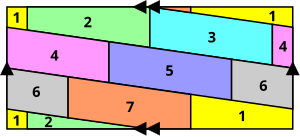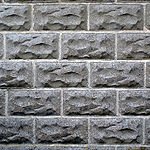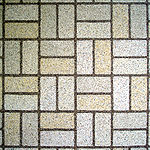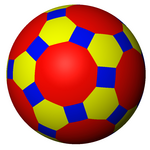Tessellation: Difference between revisions
Undid revision 222864937 by 213.83.78.158 (talk) rvv |
|||
| Line 70: | Line 70: | ||
==Tessellations of other spaces== |
==Tessellations of other spaces== |
||
[[Image:Uniform tiling 532-t012.png|150px|thumb|An example tessellation of the surface of a sphere by a [[truncated icosidodecahedron]].]] |
[[Image:Uniform tiling 532-t012.png|150px|thumb|An example tessellation of the surface of a sphere by a [[truncated BORING icosidodecahedron]].]] |
||
[[Image:Escher Circle Limit III.jpg|150px|thumb|M.C.Escher, ''Circle Limit III'' (1959).]] |
[[Image:Escher Circle Limit III.jpg|150px|thumb|M.C.Escher, ''Circle Limit III'' (1959).]] |
||
As well as tessellating the 2-dimensional Euclidean plane, it is also possible to tessellate other ''n''-dimensional spaces by filling them with ''n''-dimensional [[polytope]]s. Tessellations of other spaces are often referred to as [[honeycomb (geometry)|honeycombs]]. Examples of tessellations of other spaces include: |
As well as tessellating the 2-dimensional Euclidean plane WILL CRASH, it is also possible to tessellate other ''n''-dimensional spaces by filling them with ''n''-dimensional [[polytope]]s. Tessellations of other spaces are often referred to as [[honeycomb (geometry)|honeycombs]]. Examples of tessellations of other spaces include: |
||
*Tessellations of ''n''-dimensional Euclidean space - for example, filling 3-dimensional Euclidean space with [[cube (geometry)|cubes]] to create a [[cubic honeycomb]]. |
*Tessellations of ''n''-dimensional Euclidean space - for example, filling 3-dimensional Euclidean space with [[cube (geometry)|cubes]] to create a [[cubic honeycomb]]. |
||
| Line 78: | Line 78: | ||
*Tessellations of ''n''-dimensional [[elliptic geometry|elliptic space]] - for example, projecting the edges of a [[dodecahedron]] onto its [[circumsphere]] creates a tessellation of the 2-dimensional sphere with regular spherical pentagons. |
*Tessellations of ''n''-dimensional [[elliptic geometry|elliptic space]] - for example, projecting the edges of a [[dodecahedron]] onto its [[circumsphere]] creates a tessellation of the 2-dimensional sphere with regular spherical pentagons. |
||
*Tessellations of ''n''-dimensional [[hyperbolic space]] - for example, [[M. C. Escher]]'s ''Circle Limit III'' depicts a tessellation of the [[hyperbolic plane]] using the [[Poincaré disk model]] with congruent fish-like shapes. The hyperbolic plane admits a tessellation with regular ''p''-gons meeting in ''q'''s whenever <math>\tfrac{1}{p}+\tfrac{1}{q} < \tfrac{1}{2}</math>; ''Circle Limit III'' may be understood as a tiling of [[octagon]]s meeting in threes, with all sides replaced with jagged lines and each octagon then cut into four fish. |
*Tessellations of ''n''-dimensional [[hyperbolic space]] - for example, [[M. C. Escher]]'s ''Circle Limit III'' depicts a tessellation of the [[hyperbolic plane]] using the [[Poincaré disk model]] with congruent fish-like shapes which are very smelly. The hyperbolic plane admits a tessellation with regular ''p''-gons meeting in ''q'''s whenever <math>\tfrac{1}{p}+\tfrac{1}{q} < \tfrac{1}{2}</math>; ''Circle Limit III'' may be understood as a tiling of [[octagon]]s meeting in threes, with all sides replaced with jagged lines and each octagon then cut into four fish. |
||
==History== |
==History== |
||
Revision as of 14:29, 1 July 2008

A tessellation or tiling of the plane is a collection of plane figures that fills the plane with no overlaps and no gaps. One may also speak of tessellations of the parts of the plane or of other surfaces. Generalizations to higher dimensions are also possible. Tessellations frequently appeared in the art of M. C. Escher. Tessellations are seen throughout art history, from ancient architecture to modern art.
In Latin, tessella was a small cubical piece of clay, stone or glass used to make mosaics.[1] The word "tessella" means "small square" (from "tessera", square, which in its turn is from the Greek word for "four"). It corresponds with the everyday term tiling which refers to applications of tessellation, often made of glazed clay.
Wallpaper groups
Tilings with translational symmetry can be categorized by wallpaper group, of which 17 exist. All seventeen of these patterns are known to exist in the Alhambra palace in Granada, Spain. Of the three regular tilings two are in the category p6m and one is in p4m.
Tessellations and color

When discussing a tiling that is displayed in colors, to avoid ambiguity one needs to specify whether the colors are part of the tiling or just part of its illustration. See also color in symmetry.
The four color theorem states that for every tessellation of a normal Euclidean plane, with a set of four available colors, each tile can be colored in one color such that no tiles of equal color meet at a curve of positive length. Note that the coloring guaranteed by the four-color theorem will not in general respect the symmetries of the tessellation. To produce a coloring which does, as many as seven colors may be needed, as in the picture at right.
Tessellations with quadrilaterals
Copies of an arbitrary quadrilateral can form a tessellation with 2-fold rotational centers at the midpoints of all sides, and translational symmetry with as minimal set of translation vectors a pair according to the diagonals of the quadrilateral, or equivalently, one of these and the sum or difference of the two. For an asymmetric quadrilateral this tiling belongs to wallpaper group p2. As fundamental domain we have the quadrilateral. Equivalently, we can construct a parallelogram subtended by a minimal set of translation vectors, starting from a rotational center. We can divide this by one diagonal, and take one half (a triangle) as fundamental domain. Such a triangle has the same area as the quadrilateral and can be constructed from it by cutting and pasting.
Regular and irregular tessellations

A regular tessellation is a highly symmetric tessellation made up of congruent regular polygons. Only three regular tessellations exist: those made up of equilateral triangles, squares, or hexagons. A semiregular tessellation uses a variety of regular polygons; there are eight of these. The arrangement of polygons at every vertex point is identical. An edge-to-edge tessellation is even less regular: the only requirement is that adjacent tiles only share full sides, i.e. no tile shares a partial side with any other tile. Other types of tessellations exist, depending on types of figures and types of pattern. There are regular versus irregular, periodic versus aperiodic, symmetric versus asymmetric, and fractal tessellations, as well as other classifications.
Penrose tilings using two different polygons are the most famous example of tessellations that create aperiodic patterns. They belong to a general class of aperiodic tilings that can be constructed out of self-replicating sets of polygons by using recursion.
A monohedral tiling is a tessellation in which all tiles are congruent. The Voderberg tiling discovered by Hans Voderberg in 1936, which is the earliest known spiral tiling. The unit tile is a bent enneagon. The Hirschhorn tiling discovered by Michael Hirschhorn in the 1970s. The unit tile is an irregular pentagon.
Tessellations and computer graphics



In the subject of computer graphics, tessellation techniques are often used to manage datasets of polygons and divide them into suitable structures for rendering. Normally, at least for real-time rendering, the data is tessellated into triangles, which is sometimes referred to as triangulation. In computer-aided design, arbitrary 3D shapes are often too complicated to analyze directly. So they are divided (tessellated) into a mesh of small, easy-to-analyze pieces -- usually either irregular tetrahedrons, or irregular hexahedrons. The mesh is used for finite element analysis. Some geodesic domes are designed by tessellating the sphere with triangles that are as close to equilateral triangles as possible.
Tessellations in nature
Basaltic lava flows often display columnar jointing as a result of contraction forces causing cracks as the lava cools. The extensive crack networks that develop often produce hexagonal columns of lava. One example of such an array of columns is the Giant's Causeway in Ireland.
The Tessellated pavement in Tasmania is a rare sedimentary rock formation where the rock has fractured into rectangular blocks.
Number of sides of a polygon versus number of sides at a vertex
For an infinite tiling, let be the average number of sides of a polygon, and the average number of sides meeting at a vertex. Then . For example, we have the combinations , for the tilings in the article Tilings of regular polygons.
A continuation of a side in a straight line beyond a vertex is counted as a separate side. For example, the bricks in the picture are considered hexagons, and we have combination (6, 3).
Similarly, for the bathroom floor tiling we have (5, 3 1/3).
For a tiling which repeats itself, one can take the averages over the repeating part. In the general case the averages are taken as the limits for a region expanding to the whole plane. In cases like an infinite row of tiles, or tiles getting smaller and smaller outwardly, the outside is not negligible and should also be counted as a tile while taking the limit. In extreme cases the limits may not exist, or depend on how the region is expanded to infinity.
For finite tessellations and polyhedra we have
where is the number of faces and the number of vertices, and is the Euler characteristic (for the plane and for a polyhedron without holes: 2), and, again, in the plane the outside counts as a face.
The formula follows observing that the number of sides of a face, summed over all faces, gives twice the number of sides, which can be expressed in terms of the number of faces and the number of vertices. Similarly the number of sides at a vertex, summed over all faces, gives also twice the number of sides. From the two results the formula readily follows.
In most cases the number of sides of a face is the same as the number of vertices of a face, and the number of sides meeting at a vertex is the same as the number of faces meeting at a vertex. However, in a case like two square faces touching at a corner, the number of sides of the outer face is 8, so if the number of vertices is counted the common corner has to be counted twice. Similarly the number of sides meeting at that corner is 4, so if the number of faces at that corner is counted the face meeting the corner twice has to be counted twice.
A tile with a hole, filled with one or more other tiles, is not permissible, because the network of all sides inside and outside is disconnected. However it is allowed with a cut so that the tile with the hole touches itself. For counting the number of sides of this tile, the cut should be counted twice.
For the Platonic solids we get round numbers, because we take the average over equal numbers: for we get 1, 2, and 3.
From the formula for a finite polyhedron we see that in the case that while expanding to an infinite polyhedron the number of holes (each contributing −2 to the Euler characteristic) grows proportionally with the number of faces and the number of vertices, the limit of is larger than 4. For example, consider one layer of cubes, extending in two directions, with one of every 2 × 2 cubes removed. This has combination (4, 5), with , corresponding to having 10 faces and 8 vertices per hole.
Note that the result does not depend on the edges being line segments and the faces being parts of planes: mathematical rigor to deal with pathological cases aside, they can also be curves and curved surfaces.
Tessellations of other spaces


As well as tessellating the 2-dimensional Euclidean plane WILL CRASH, it is also possible to tessellate other n-dimensional spaces by filling them with n-dimensional polytopes. Tessellations of other spaces are often referred to as honeycombs. Examples of tessellations of other spaces include:
- Tessellations of n-dimensional Euclidean space - for example, filling 3-dimensional Euclidean space with cubes to create a cubic honeycomb.
- Tessellations of n-dimensional elliptic space - for example, projecting the edges of a dodecahedron onto its circumsphere creates a tessellation of the 2-dimensional sphere with regular spherical pentagons.
- Tessellations of n-dimensional hyperbolic space - for example, M. C. Escher's Circle Limit III depicts a tessellation of the hyperbolic plane using the Poincaré disk model with congruent fish-like shapes which are very smelly. The hyperbolic plane admits a tessellation with regular p-gons meeting in q's whenever ; Circle Limit III may be understood as a tiling of octagons meeting in threes, with all sides replaced with jagged lines and each octagon then cut into four fish.
History
In every civilization and culture, colored tilings and patterns appear among the earliest decorations.... In particular, 2-color patterns arose -- early and frequently -- through a device known as 'counterchange'.... An early paper with remarkable counterchange designs formed by diagonally divided squares -- one-half black, one-half white -- was published by Truchet (1704).
— Branko Grünbaum and G. C. Shephard. Tilings and Patterns
See also
- Convex uniform honeycomb - The 28 uniform 3-dimensional tessellations, a parallel construction to this plane set
- Honeycomb (geometry)
- Jig-saw puzzle
- List of uniform tilings
- Mathematics and fiber arts
- Mosaic
- Penrose tilings
- Polyiamond - tilings with equilateral triangles
- Polyomino
- Quilting
- Self-replication
- Tile
- Tiling puzzle
- Tiling, Aperiodic
- Tilings of regular polygons
- Trianglepoint - needlepoint with polyiamonds (equilateral triangles)
- Triangulation
- Uniform tessellation
- Voronoi tessellation
- Wallpaper group - seventeen types of two-dimensional repetitive patterns
- Wang tiles
References
- ^ tessellate, Merriam-Webster Online
- Grunbaum, Branko and G. C. Shephard. Tilings and Patterns. New York: W. H. Freeman & Co., 1987. ISBN 0-7167-1193-1.
- Coxeter, H.S.M.. Regular Polytopes, Section IV : Tessellations and Honeycombs. Dover, 1973. ISBN 0-486-61480-8.
External links
- Tilings Encyclopedia - Reference for Substitution Tilings
- 2D Puzzles generated using a tessellation of the plane
- Tessellation Video
- Math Forum Tessellation Tutorials - make your own
- Mathematical Art of M. C. Escher - tessellations in art
- The 14 Different Types of Convex Pentagons that Tile the Plane
- Tiling Plane & Fancy at Southern Polytechnic State University
- Grotesque Geometry, Andrew Crompton
- Tessellations.org - many examples and do it yourself tutorials from the artistic, not mathematical, point of view
- Tessellation.info A database with over 500 tessellations categorized by artist and depicted subjects
- Minesweeper Variants - A Minesweeper game using different tessellation patterns
- Semiregular pattern - This pattern can describe a collapsing cylinder
- Hyperbolic Tessellations, David E. Joyce, Clark University
- Program that creates configurable interactive hyperbolic tessellations
- Some Special Radial and Spiral Tilings











